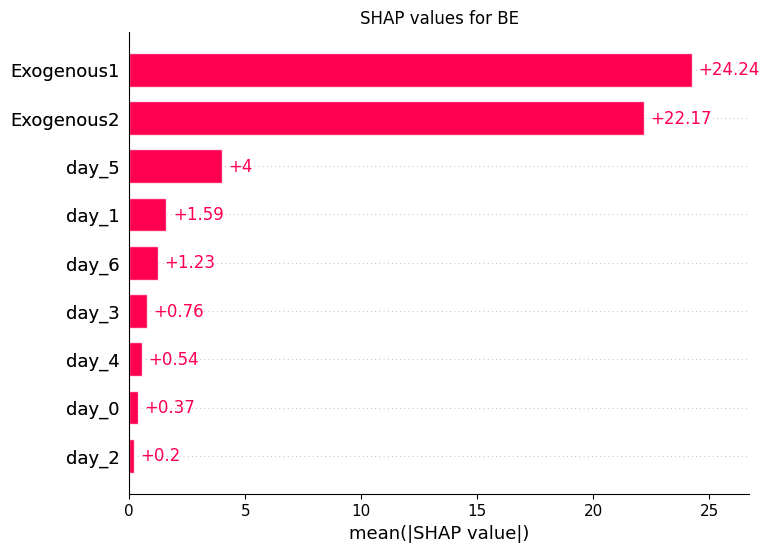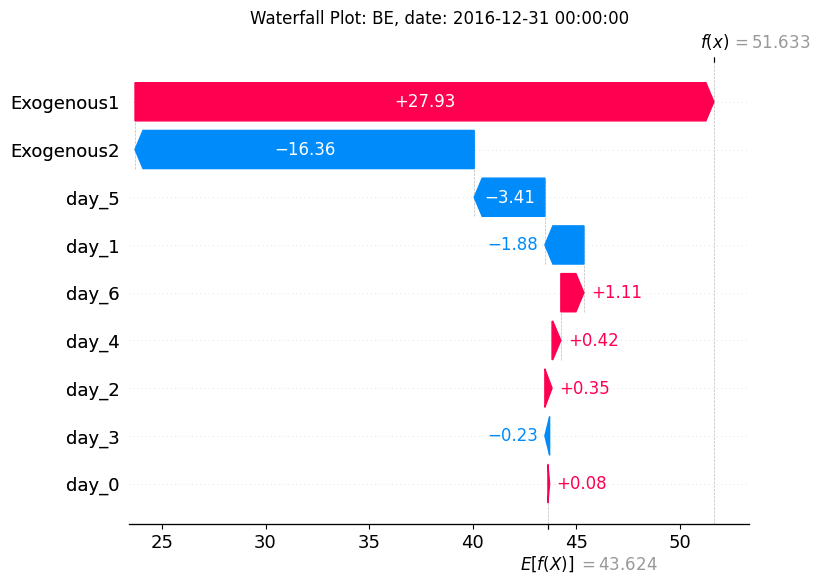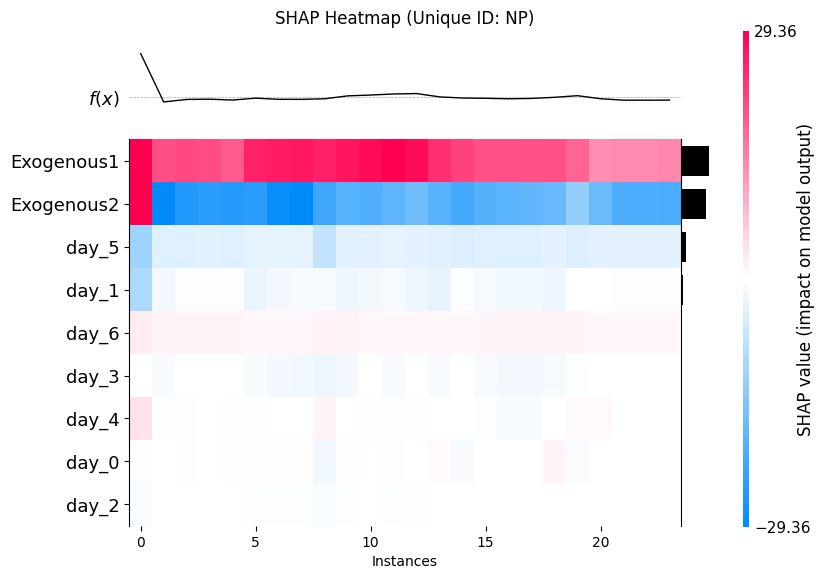shap package must be installed separately as it is not a
dependency of nixtla.
shap can be installed from either
PyPI or
conda-forge:
1. Import packages
First, we import the required packages and initialize the Nixtla client.👍 Use an Azure AI endpoint To use an Azure AI endpoint, remember to set also thebase_urlargument:nixtla_client = NixtlaClient(base_url="you azure ai endpoint", api_key="your api_key")
2. Load data
In this example on SHAP values, we will use exogenous variables (also known as covariates) to improve the accuracy of electricity market forecasts. We’ll work with a well-known dataset calledEPF, which is
publicly accessible here.
This dataset includes data from five different electricity markets, each
with unique price dynamics, such as varying frequencies and occurrences
of negative prices, zeros, and price spikes. Since electricity prices
are influenced by exogenous factors, each dataset also contains two
additional time series: day-ahead forecasts of two significant exogenous
factors specific to each market.
For simplicity, we will focus on the Belgian electricity market (BE).
This dataset includes hourly prices (y), day-ahead forecasts of load
(Exogenous1), and electricity generation (Exogenous2). It also
includes one-hot encoding to indicate whether a specific date is a
specific day of the week. Eg.: Monday (day_0 = 1), a Tuesday
(day_1 = 1), and so on.
If your data depends on exogenous factors or covariates such as prices,
discounts, special holidays, weather, etc., you can follow a similar
structure.
| unique_id | ds | y | Exogenous1 | Exogenous2 | day_0 | day_1 | day_2 | day_3 | day_4 | day_5 | day_6 | |
|---|---|---|---|---|---|---|---|---|---|---|---|---|
| 0 | BE | 2016-10-22 00:00:00 | 70.00 | 57253.0 | 49593.0 | 0.0 | 0.0 | 0.0 | 0.0 | 0.0 | 1.0 | 0.0 |
| 1 | BE | 2016-10-22 01:00:00 | 37.10 | 51887.0 | 46073.0 | 0.0 | 0.0 | 0.0 | 0.0 | 0.0 | 1.0 | 0.0 |
| 2 | BE | 2016-10-22 02:00:00 | 37.10 | 51896.0 | 44927.0 | 0.0 | 0.0 | 0.0 | 0.0 | 0.0 | 1.0 | 0.0 |
| 3 | BE | 2016-10-22 03:00:00 | 44.75 | 48428.0 | 44483.0 | 0.0 | 0.0 | 0.0 | 0.0 | 0.0 | 1.0 | 0.0 |
| 4 | BE | 2016-10-22 04:00:00 | 37.10 | 46721.0 | 44338.0 | 0.0 | 0.0 | 0.0 | 0.0 | 0.0 | 1.0 | 0.0 |
3. Forecasting electricity prices using exogenous variables
To produce forecasts we also have to add the future values of the exogenous variables. If your forecast depends on other variables, it is important to ensure that those variables are available at the time of forecasting. In this example, we know that the price of electricity depends on the demand (Exogenous1) and the quantity produced (Exogenous2). Thus, we need
to have those future values available at the time of forecasting. If
those values were not available, we can always use TimeGPT to forecast
them.
Here, we read a dataset that contains the future values of our features.
In this case, we want to predict 24 steps ahead, therefore each
unique_id will have 24 observations.
Important If you want to use exogenous variables when forecasting with TimeGPT, you need to have the future values of those exogenous variables too.
| unique_id | ds | Exogenous1 | Exogenous2 | day_0 | day_1 | day_2 | day_3 | day_4 | day_5 | day_6 | |
|---|---|---|---|---|---|---|---|---|---|---|---|
| 0 | BE | 2016-12-31 00:00:00 | 70318.0 | 64108.0 | 0.0 | 0.0 | 0.0 | 0.0 | 0.0 | 1.0 | 0.0 |
| 1 | BE | 2016-12-31 01:00:00 | 67898.0 | 62492.0 | 0.0 | 0.0 | 0.0 | 0.0 | 0.0 | 1.0 | 0.0 |
| 2 | BE | 2016-12-31 02:00:00 | 68379.0 | 61571.0 | 0.0 | 0.0 | 0.0 | 0.0 | 0.0 | 1.0 | 0.0 |
| 3 | BE | 2016-12-31 03:00:00 | 64972.0 | 60381.0 | 0.0 | 0.0 | 0.0 | 0.0 | 0.0 | 1.0 | 0.0 |
| 4 | BE | 2016-12-31 04:00:00 | 62900.0 | 60298.0 | 0.0 | 0.0 | 0.0 | 0.0 | 0.0 | 1.0 | 0.0 |
forecast method, adding this information. To access the
SHAP values, we also need to specify feature_contributions=True in the
forecast method.
| unique_id | ds | TimeGPT | TimeGPT-hi-80 | TimeGPT-hi-90 | TimeGPT-lo-80 | TimeGPT-lo-90 | |
|---|---|---|---|---|---|---|---|
| 0 | BE | 2016-12-31 00:00:00 | 51.632830 | 61.598820 | 66.088295 | 41.666843 | 37.177372 |
| 1 | BE | 2016-12-31 01:00:00 | 45.750877 | 54.611988 | 60.176445 | 36.889767 | 31.325312 |
| 2 | BE | 2016-12-31 02:00:00 | 39.650543 | 46.256210 | 52.842808 | 33.044876 | 26.458277 |
| 3 | BE | 2016-12-31 03:00:00 | 34.000072 | 44.015310 | 47.429000 | 23.984835 | 20.571144 |
| 4 | BE | 2016-12-31 04:00:00 | 33.785370 | 43.140503 | 48.581240 | 24.430239 | 18.989498 |
4. Extract SHAP values
Now that we have made predictions using exogenous features, we can then extract the SHAP values to understand their relevance using thefeature_contributions attribute of the client. This returns a
DataFrame containing the SHAP values and base values for each series, at
each step in the horizon.
| unique_id | ds | TimeGPT | Exogenous1 | Exogenous2 | day_0 | day_1 | day_2 | day_3 | day_4 | day_5 | day_6 | base_value | |
|---|---|---|---|---|---|---|---|---|---|---|---|---|---|
| 0 | BE | 2016-12-31 00:00:00 | 51.632830 | 27.929638 | -16.363607 | 0.081917 | -1.883555 | 0.346484 | -0.228611 | 0.424167 | -3.411662 | 1.113910 | 43.624146 |
| 1 | BE | 2016-12-31 01:00:00 | 45.750877 | 17.678530 | -12.240089 | -0.758545 | -0.077536 | -0.160390 | -0.309567 | 0.871469 | -3.927268 | 1.218714 | 43.455560 |
| 2 | BE | 2016-12-31 02:00:00 | 39.650543 | 21.632694 | -21.400244 | -0.926842 | -0.470276 | -0.022417 | -0.225389 | 0.220258 | -3.927268 | 1.145736 | 43.624290 |
| 3 | BE | 2016-12-31 03:00:00 | 34.000072 | 13.879354 | -20.681124 | -0.114050 | -0.488141 | 0.048164 | -0.126627 | 0.200692 | -3.400485 | 1.144959 | 43.537330 |
| 4 | BE | 2016-12-31 04:00:00 | 33.785370 | 13.465129 | -20.619830 | -0.036112 | -0.470496 | 0.048375 | -0.126627 | 0.200692 | -3.400485 | 1.144959 | 43.579760 |
5. Make plots using shap
Now that we have access to SHAP values we can use the shap package to
make any plots that we want.
5.1 Bar plot
Here, let’s make bar plots for each series and their features, so we can see which features impacts the predictions the most.
Exogenous1 is the most important feature, as it has
the largest average contribution. Remember that it designates the
expected energy demand, so we can see that this variable has a large
impact on the final prediction. On the other hand, day_2 is the least
important feature, since it has the lowest value.
5.2 Waterfall plot
Now, let’s see how we can make a waterfall plot to explore the the impact of features at a single prediction step. The code below selects a specific date. Of course, this can be modified for any series or date.
E[f(X)] which represents the baseline value (the predicted value if
exogenous features were unknown).
Then, we see how each feature has impacted the final forecast. Features
like day_3, day_1, day_5, Exogenous2 all push the forecast to
the left (smaller value). On the other hand, day_0, day_2, day_4,
day_6 and Exogenous1 push it to the right (larger value).
Let’s think about this for a moment. In the introduction, we stated that
Exogenous1 represents electricity load, whereas Exogenous2
represents electricity generation. * Exogenous1, the electricity
load, adds positively to the overall prediction. This seems reasonable:
if we expect a higher demand, we might expect the price to go up. *
Exogenous2, on the other hand, adds negatively to the overall
prediction. This seems reasonable too: if there’s a higher electricity
generation, we expect the price to be lower. Hence, a negative
contribution to the forecast for Exogenous2.
At the top right, we see f(x) which is the final output of the model
after considering the impact of the exogenous features. Notice that this
value corresponds to the final prediction from TimeGPT.
5.3 Heatmap
We can also do a heatmap plot to see how each feature impacts the final prediction. Here, we only need to select a specific series.
Exogenous1 is the most important, and day_6 is the least important.
Then, the color of the heatmap indiciates if the feature tends to
increase of decrease the final prediction at each forecasting step. For
example, Exogenous1 always increases predictions across all 24 hours
in the forecast horizon.
We also see that all days except day_5 do not have a very large impact
at any forecasting step, indicating that they barely impacting the final
prediction.
Ultimately, the feature_contributions attribute gives you access to
all the necessary information to explain the impact of exogenous
features using the shap package.
